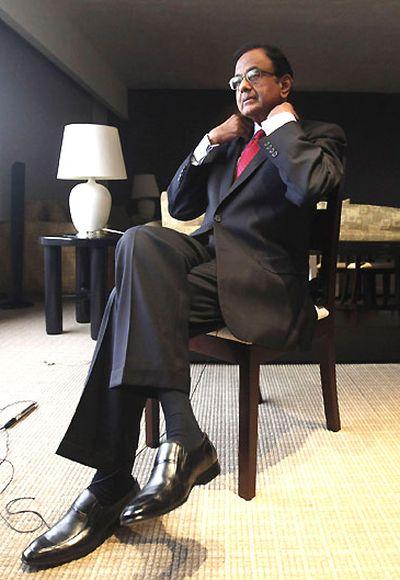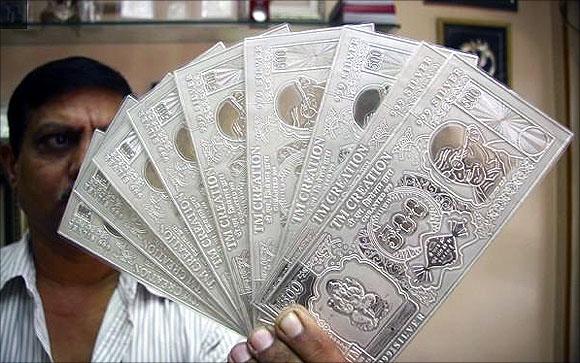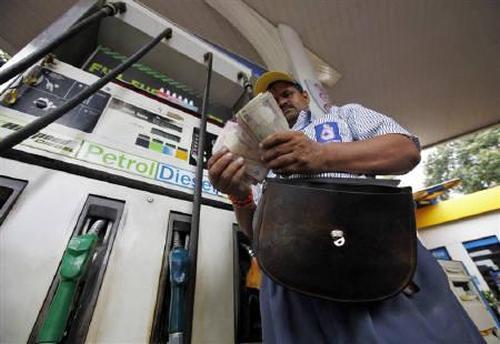Photographs: Edgard Garrido/Reuters A K Bhattacharya in New Delhi
Earlier in the year, the Finance Minister was able to bring down fiscal deficit thanks to the strong rupee and rising stock market. With the tide turning, it will be difficult for him to achieve his set targets.
Finance Minister P Chidambaram will complete one year in office in a little less than five weeks from now.
He returned to the finance ministry on August 1, 2012, a few days after Pranab Mukherjee shifted to the Rashtrapati Bhavan as the 13th president of India.
So, it is a good time to look back and see how Mr Chidambaram has fared since his return to the finance ministry.
Fiscal consolidation, without doubt, would be counted as his most important achievement in the last 11 months.
The Budget for 2012-13, presented by Pranab Mukherjee, had set a fiscal deficit target of 5.1 per cent. When Mr Chidambaram took charge of the finance ministry in August 2012, that target had become almost unachievable.
…
How Chidambaram fared since his return to finance ministry
Photographs: B Mathur/Reuters
A slowing economy had led to lower revenue collections than had been projected. The oil subsidies bill had risen since the government lacked the political guts to go ahead with the promised reforms in petroleum product prices.
And the government's failure to take decisions and act on them had begun to harm the economy's overall investment climate.
Until Mr Chidambaram took charge of the finance ministry, the government's response to this crisis was one of shock and denial. Nobody in the government was willing to accept the harsh reality of a slowing economy, worsening fiscal balance and stalled reforms.
Instead, many of them were actually predicting how the economy was close to bottoming out and the worst had just got over.
The big difference the new finance minister made was in accepting the reality as it existed. He quickly followed that up with the formation of a few committees headed by experts.
…
How Chidambaram fared since his return to finance ministry
Image: Opening up FDI in retail sector was one of the biggest reforms under Chidambaram's tenure in the past one year.Photographs: Alex Grimm/Reuters
That, in retrospect, was a smart move. The reports of these committees (headed by economists like Vijay L Kelkar and Parthasarathi Shome, who later joined the finance minister as his advisor) validated the concerns about India's worsening economic prospects and outlined a set of policy measures to bail the economy out of its current state.Armed with these reports, Mr Chidambaram first sensitised the political leadership, essentially the Congress high command, about the economic problems and the need to take tough measures.
Later, he took on board his ministerial colleagues on the need to initiate the necessary steps, including those aimed at relaxing norms for foreign investment in some sectors.
With no sign of a pickup in revenue collections and even the disinvestment programme failing to gain the desired momentum, Mr Chidambaram's only option was to crack down on the government's expenditure budget.
If nothing was done, the government's fiscal deficit was threatening to widen to 6.1 per cent of GDP, a slippage of one percentage point over the Budget target.
…
How Chidambaram fared since his return to finance ministry
Image: A jeweller displays silver plates in the form of Indian rupee notes in Chnadigarh.Photographs: Ajay Verma/Reuters
Thus, in the first round of cuts, he proposed to bring the fiscal deficit down to 5.3 per cent. That announcement itself was a confidence-boosting measure, giving hope to investors and economic agents that the government meant business.
That was not all. While presenting the Budget for 2013-14 last February, he announced that the revised fiscal deficit for 2012-13 was kept below 5.2 per cent.
And a few months later, a fresh set of numbers showed that the actual fiscal deficit for that year was further brought down to 4.9 per cent of GDP.
With the new number, the fiscal deficit target of 4.8 per cent for the current year looks to be an easy goal to achieve.
Indeed, there is now some expectation that the finance minister should be able to effect a further reduction in the fiscal deficit for 2013-14.
Will that be possible? The task looks very difficult. Consider the three additional factors that helped Mr Chidambaram bring down the government's fiscal deficit last year: a strengthening rupee, a rising Sensex (the Bombay Stock Exchange's benchmark index), and a moderate level of crude oil prices.
…
How Chidambaram fared since his return to finance ministry
Image: Finance Mnister P Chidambaram poses next to the bronze statue of a bull outside the Bombay Stock Exchange.Photographs: Reuters
The three factors are inter-related. A strengthening rupee helped buoy up the stock market sentiment, which brought in more portfolio investment from abroad, and a moderate level of Brent crude oil prices meant no further adverse impact on the oil companies' under-recoveries.
Now look at where the rupee has moved since Mr Chidambaram joined the finance ministry. It was ruling at 55.47 a dollar on August 1, 2012 and moved up to 52 by October and stayed at around 52-53 till May 2013.
Remember a strengthening rupee gave him the much-needed cushion for oil and fertiliser subsidies.
In the last two months, the rupee has depreciated by more than 10 per cent and threatens to fall further. That means the finance minister's task of reining in subsidies on imported products would be even more difficult.
The Sensex had moved up from 17,250 in August 2012 to around 20,000 in February 2013. But now it is hovering around 18,000, as foreign institutional investors are turning net sellers.
…
How Chidambaram fared since his return to finance ministry
Image: After touching about $118 a barrel in February, Brent crude is now moving in the range of $100-105 a barrel.Photographs: Reuters
It is only the Brent crude oil price that is giving the finance minister some comfort. After touching about $118 a barrel in February, it is now moving in the range of $100-105 a barrel. But the gains from this have been somewhat neutralised by the rupee's depreciation.
The saving grace is the government's decision to free petrol prices and introduce a phased decontrol of diesel prices. That may limit the fiscal damage, but would not completely eliminate the problem.
The point to be noted here is that Mr Chidambaram did remarkably well in cutting government expenditure last year.
But that exercise was aided by a combination of positive developments like the strengthening rupee and a buoyant stock market.
This year he may not be able to be as ruthless in cutting expenditure because of elections. And worse, he may have run out of his luck with the currency and the stock market.








article